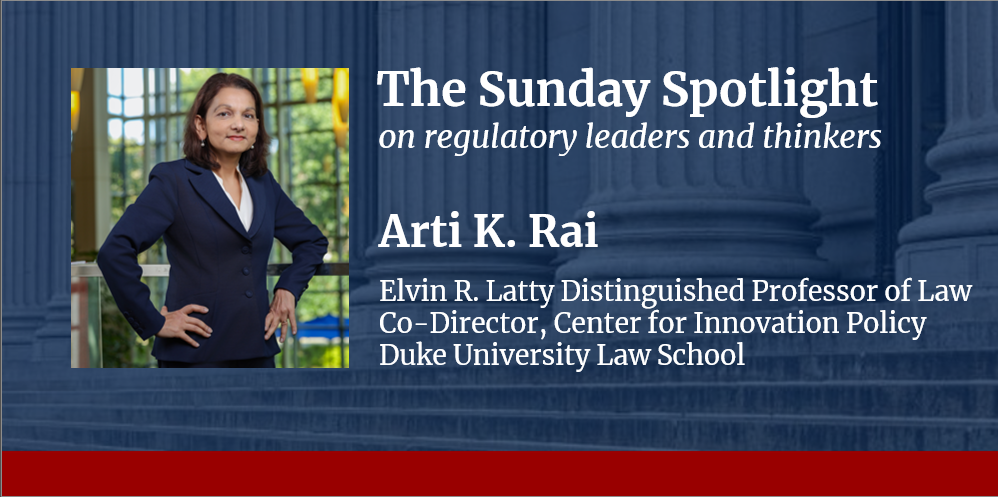
Arti K. Rai explores how patent regulators can enable future innovation.
In a conversation with The Regulatory Review, Arti K. Rai, an expert on intellectual property and administrative law, discusses how the U.S. Patent and Trademark Office (USPTO) and other federal regulators can keep up with evolving technologies and enable scientific breakthroughs.
Recent cuts to scientific research funding by the current Administration have raised questions about how the future of innovation and new scientific developments will be affected. Rai explains how federal regulators have and can continue to encourage new scientific developments despite research funding reductions.
Rai outlines how the USPTO and entities under it, such as the Patent Trial and Appeals Board (PTAB), operate and interact with other institutions, including federal courts, to review patent applications. She advocates using artificial intelligence (AI) to assist with reviewing patent applications at the USPTO, arguing that current legal frameworks provide sufficient oversight over the use of AI. Rai also explains how the USPTO Office of the Chief Economist, which she helped establish, has facilitated scholarship on innovation and entrepreneurship.
Rai highlights how improvements to patent regulation can help increase access to innovation and combat reductions in federally funded research. For example, she explains how empirical data suggest that current laws governing the PTAB and the ability of manufacturers to market generic drugs must be reformed to encourage manufacturers to file patent challenges with the PTAB. Rai also explains how patent regulation by the USPTO and reimbursement rates set by the Centers for Medicare and Medicaid Services (CMS) can interact to reduce barriers to accessing innovative drugs. She concludes by emphasizing the importance of federally funded research in encouraging scientific innovation and arguing that although current systems of funding research could be improved, the Trump Administration’s drastic reductions in funding are unlikely to spark necessary change.
Rai is the Elvin R. Latty Distinguished Professor of Law and co-director of the Center for Innovation Policy at Duke University School of Law. She is also a member of the National Academies’ Forum on Drug Discovery, Development, and Translation, the Polaris Advisory Council to the Government Accountability Office, and the American Law Institute. Rai served previously as a senior advisor to the U.S. Department of Commerce’s Office of General Counsel on innovation policy issues and as a public member of the Administrative Conference of the United States. Rai led the Office of Policy and International Affairs at the USPTO from 2009 to 2010, where she oversaw policy analysis of patent reform legislation. Her work has appeared in journals such as Science, The New England Journal of Medicine, and the Journal of Law and Biosciences.
The Regulatory Review is pleased to share the following interview with Arti K. Rai.
The Regulatory Review: What institutions regulate patents in the United States, and how do they work together?
Rai: The USPTO uses ex parte proceedings to evaluate patent applications for compliance with the validity standards of the patent statute. Although courts give the USPTO’s legal determinations little, if any, deference, USPTO evaluations nonetheless carry some weight because applying patent law’s legal standards can be quite fact-intensive. The U.S. Court of Appeals for the Federal Circuit hears appeals from USPTO patent denials as well as all appeals from infringement actions brought by patent owners in federal district courts from around the country. Infringement defendants can contest not only infringement but also validity. Infringement defendants as well as other parties interested in challenging the validity of granted patents can also petition the USPTO’s PTAB for an inter partes challenge. Post-grant decisions of the PTAB are appealed to the Federal Circuit.
TRR: You have written about using AI for patent evaluations at the USPTO. What regulatory safeguards should be in place to enable the use of artificial intelligence?
Rai: The patent statute requires the USPTO to determine whether a patent application is “nonobvious” given the prior literature, both patent and non-patent, in the application’s scientific or technical field. Because searches for the most relevant prior literature can be very time-intensive, AI use could yield substantial efficiency. I have argued that using AI for searches should not require any additional regulatory safeguards. As a constitutional matter, patent applications do not represent rights to which due process protections attach. As a statutory and policy matter, once examiners have determined the references in the prior literature that they think are most relevant for showing potential obviousness, standard patent and administrative law already requires examiners to document the reasons for this relevance in the record.
TRR: You helped establish the Office of the Chief Economist at the USPTO. What is the role of this office, and why is it important?
Rai: Intellectual property, and particularly patents, exists primarily to serve the economic goal of promoting innovation. Yet prior to the creation of the Office of the Chief Economist, the USPTO differed from other economically focused federal agencies in that it lacked an economic research function spearheaded by a dedicated group of Ph.D.-level social scientists. Since its creation, the Office has produced many influential research papers on the intellectual property policy levers that promote innovation, entrepreneurship, and economic performance. The Office has also advised on economic questions raised by USPTO operations—for example, questions about patent quality and application backlog. Through conferences, visiting scholar programs, and public dissemination of invaluable patent and trademark research datasets, the Office maintains a close relationship with the academic patent research community.
TRR: You have written about generic drug manufacturers’ inability to use the PTAB as a “less cumbersome alternative” to resolving disputes in federal district court. What is one change that could be made to the PTAB to reduce manufacturers’ barrier to entry?
Rai: The empirical data support legislative reform that would lift the automatic 30-month stay of a generic’s approval by the U.S. Food and Drug Administration once the PTAB invalidates a brand-name patent. Current law that keeps the stay in place until courts act to lift it disincentives PTAB challenges.
TRR: You have written about the legal barriers to accessing biomedical innovation. Can you describe some of these barriers and how regulators, including the USPTO, can help increase access to innovation?
Rai: Important regulatory levers include patents as well as public insurance reimbursement. On the patent end, we know from multiple studies that patent incentives are quite important for biopharmaceutical innovation. So radical change is inadvisable. But not all biomedical patents are created equal. Specifically, there is good reason to be concerned about large numbers of relatively incremental or even invalid patents that extend exclusivity protection. Various bills in Congress would increase USPTO scrutiny and limit enforceability. On the reimbursement side, provisions in the Inflation Reduction Act that give regulators at CMS the power to demand price discounts once a branded drug has enjoyed a defined period of exclusivity may also have some positive impact. Here, too, however, CMS should be cautious, as the Inflation Reduction Act’s price discount provisions do not necessarily account fully for the health value of a given drug.
TRR: As the new presidential Administration continues to reduce funding for biomedical research, what are your predictions for the future of scientific innovation?
Rai: Publicly funded research has played a critical role not only in promoting innovation but also economic growth and social welfare more generally. One study from the Federal Reserve Bank of Dallas recently estimated that publicly funded research produced almost one-quarter of productivity growth in the post-World War II era. Many analysts agree that the U.S. system of biomedical research funding could be improved, particularly by encouraging more high-risk, high-reward endeavors by younger investigators. But arbitrary reductions of the sort that the current Administration pose a severe threat to the historical preeminence of U.S. science.



